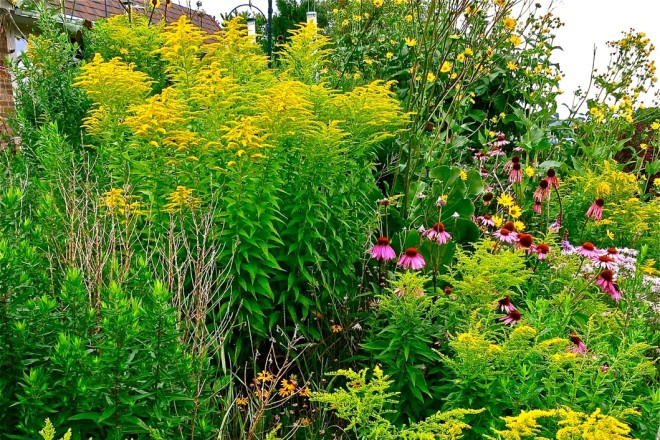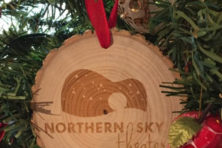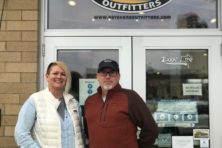Going Native: A Golden Opportunity
- Share
- Tweet
- Pin
- Share

by Dale Goodner
There’s good news, and more good news. Native plants are gaining in popularity, and December happens to be a good time to plant. Seeds can be sown right over the ground or snow (that’s what the wind does, after all). Moisture, freezing and thawing will soften the seed coats and help germination when the weather warms up. From Black-Eyed Susan to Blazing Star, from Milkweed to Goldenrod, there are many varieties that will add interest to your yard.
Of the native flowers we have in our landscape, Goldenrods are a favorite. Why plural? Because there are so many varieties. Botanists identify 24 species found in Wisconsin, 25 if you consider “tall” and “Canada” to be separate. Throughout North America there are several dozen more varieties. Goldenrods grow in all conditions, from old fields to shaded forests to wetlands. I particularly like “showy” and “stiff” goldenrod. The showy has a huge tuft of bright yellow flowers and a maroon stem. Stiff has large leaves, that contrast nicely with other plants. Their bright yellow looks great next to the purple of New England Aster and Purple Coneflower.
These beautiful plants provide golden opportunities for countless beneficial native insects to feed in summer and fall. There’s even a Goldenrod Crab Spider. In winter, the seeds protrude above snow and attract Goldfinch, Pine Siskins, Juncos and Tree Sparrows. Ruffed Grouse and Cottontails also feed on Goldenrod. Alabama, Kentucky and Nebraska list Goldenrod as their “state flower,” and at one time, it had even been suggested as our national flower.
Commonly blamed for attacks of hay fever, Goldenrods are innocent. Their pollen is heavy and sticky and dispersed by insects, which are attracted to both pollen and nectar. Because some goldenrods can be found growing in disturbed areas along with such weedy plants as ragweed (which is wind pollinated), they can be wrongly labeled as hay fever culprits. I like to point out to kids, let this be a lesson: Be careful with whom you hang out; their reputation could rub off on you.
Goldenrods are a terrific choice for natural landscaping. They are “grateful,” in the sense of growing well without a lot of effort and coaxing from the gardener. They are an excellent foundation for a healthy landscape that supports life. Most will grow to about three feet tall and produce spikes of showy yellow flowers that bloom in late summer and fall.
The scientific name, “Solidago,” derives from Latin, and means “to make whole.” It is reputed to heal wounds, hence the old colloquial name, “woundwort.” If you want to identify various species of goldenrods, you need to pay attention to the overall look of the inflorescence, not just to a flower. Leaf shape is also important in differentiating species.
Check with local growers to find sources for goldenrod seeds or seedlings. Now is a great time to gather seeds yourself and spread them in your landscape, where you’d like to add some color, texture and bird activity.
“Going Native” is an occasional series from the Door County Chapter of Wild Ones. Wild Ones: Native Plants, Natural Landscapes promotes environmentally sound practices to encourage biodiversity through the preservation, restoration and establishment of native plant communities. The Door County chapter of Wild Ones aims to share knowledge and experience in natural landscaping by means of nature walks, yard visits and lectures. For more information visit wildones.org.




